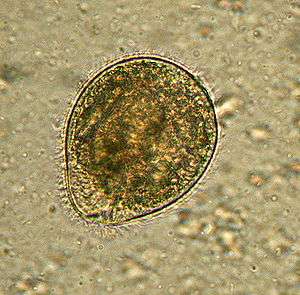Litostomatea
| Litostomatea | |
|---|---|
 | |
| Balantidium coli (Vestibulifera) | |
| Scientific classification | |
| Domain: | Eukaryota |
| (unranked): | SAR |
| (unranked): | Alveolata |
| Phylum: | Ciliophora |
| Class: | Litostomatea Small & Lynn 1981 |
| Typical orders | |
|
Subclass Haptoria | |
The Litostomatea are a class of ciliate protists.[1] Until recently, the class Litostomatea was divided into two groups, the Haptoria and the Trichostomatia. However, new genetic information has resulted in the resurrection of a third subclass, Rhynchostomatia, first proposed by A. W. Jankowski in 1980.[2] The Haptoria includes mostly carnivorous forms, for instance Didinium, a species of which preys primarily on the ciliate Paramecium. The Trichostomatia (trichostomes) are mostly endosymbionts in the digestive tracts of vertebrates. These include the species Balantidium coli, which is the only ciliate parasitic in humans. The Rhynchostomatia include two free-living genera previously included among the Haptoria, but now discovered to be genetically distinct from them, the Dileptida and the Tracheliida.[3]
The body cilia arise from monokinetids, which have an ultrastructural arrangement characteristic to the group. The mouth is apical or subapical. In trichostomes it lies in a depression, or vestibule, containing modified somatic cilia. In one order, the Entodiniomorphida, the cilia are arranged into tufts or bands, and may be packed together to form syncilia, resembling the membranelles and cirri of spirotrichs (with which they were originally classified) and other ciliates. However, no true compound cilia occur.
In haptorians the mouth is typically surrounded by a ring of coronal cilia, arising from dikinetids derived from the anterior of the body kineties, and a ring of characteristic extrusomes called toxicysts. These discharge on contact with prey, penetrating and immobilizing them, and beginning digestion. In some forms the mouth is formed only during feeding, and everts to assist in capture. The cytopharynx takes the form of a straight tube, supported by rods or nematodesmata, which dilates greatly during ingestion. This structure is called a rhabdos, and is functionally and structurally distinct from the cyrtos found in several other classes.
References
- ↑ Gao S, Song W, Ma H, et al. (2008). "Phylogeny of six genera of the subclass Haptoria (Ciliophora, Litostomatea) inferred from sequences of the gene coding for small subunit ribosomal RNA". J. Eukaryot. Microbiol. 55 (6): 562–6. doi:10.1111/j.1550-7408.2008.00360.x. PMID 19120803.
- ↑ Vd'ačný, P.; Orsi, W.; Bourland, W.A.; Shimano, S.; Epstein, S.S.; Foissner, W. (May 2011). "Phylogeny and Classification of the Litostomatea (Protista, Ciliophora), with Emphasis on Free-Living Taxa and the 18S rRNA Gene". Mol Phylogenet Evol. 59 (2): 510–22. doi:10.1016/j.ympev.2011.02.016. PMID 21333743.
- ↑ Vďačný, Peter; et al. (November 2011). "Morphological and molecular phylogeny of dileptid and tracheliid ciliates: Resolution at the base of the class Litostomatea (Ciliophora, Rhynchostomatia)". Eur J Protistol. 47 (4): 295–313. doi:10.1016/j.ejop.2011.04.006. PMC 3234341
 . PMID 21641780.
. PMID 21641780.
- "Litostomatea". NCBI Taxonomy Browser. 5988.